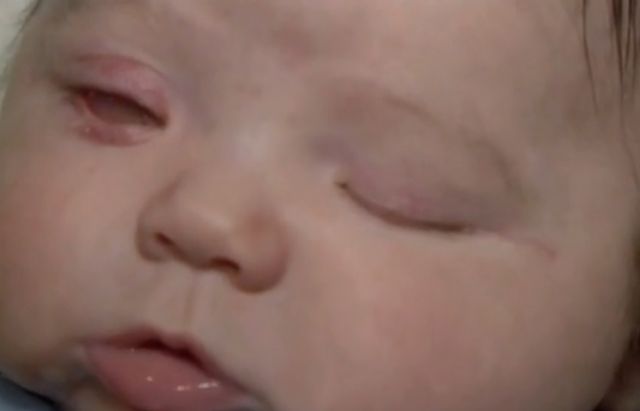Bilateral Anophthalmia: Understanding The Rare Condition Of Babies Born Without Eyes

Table of Contents
Causes of Bilateral Anophthalmia
Bilateral anophthalmia's etiology is complex and often involves a combination of genetic and environmental factors. Pinpointing the exact cause remains challenging in many cases.
Genetic Factors
Genetic mutations play a significant role in the development of bilateral anophthalmia. Several genes have been implicated, and the condition is often associated with specific genetic syndromes.
-
Examples of Genetic Syndromes:
- CHARGE syndrome (coloboma, heart defects, atresia choanae, retarded growth and/or development, genital and/or urinary anomalies, ear anomalies and deafness)
- Walker-Warburg syndrome (a severe disorder affecting the brain, eyes, and muscles)
- Other less common syndromes can also include anophthalmia as a feature.
-
Genetic Testing: Genetic testing can help identify specific gene mutations responsible for bilateral anophthalmia in some cases, aiding in diagnosis and informing family planning. This testing can provide valuable information about the risk of recurrence in future pregnancies.
Environmental Factors
While genetics are often central, environmental factors during pregnancy can also contribute to the development of anophthalmia. These factors can interact with genetic predispositions to increase the risk.
- Teratogens: Exposure to certain teratogens (substances that cause birth defects) during critical periods of fetal development can disrupt eye formation.
- Maternal Health Issues: Conditions like uncontrolled diabetes during pregnancy can increase the risk of birth defects, including anophthalmia.
- Infections: Certain viral infections contracted during pregnancy might also contribute to the development of anophthalmia. Prenatal care aims to mitigate these risks.
The importance of comprehensive prenatal care cannot be overstated in reducing the risks associated with birth defects, including bilateral anophthalmia.
Diagnosis and Testing
Early diagnosis is crucial for planning appropriate intervention and support. Diagnosis can be achieved through prenatal and postnatal methods.
Prenatal Diagnosis
Identifying bilateral anophthalmia before birth can provide parents with time to prepare and access support services.
-
Ultrasound: Ultrasound scans during pregnancy can sometimes detect the absence of eyes. However, the accuracy depends on several factors, including the gestational age and the skill of the sonographer.
-
MRI (Magnetic Resonance Imaging): MRI can offer a more detailed image of the fetal anatomy, improving the accuracy of detecting anophthalmia in some cases.
-
Limitations of Prenatal Diagnosis: It’s important to note that prenatal diagnosis isn't always conclusive, and further investigation might be necessary after birth. The emotional impact of a prenatal diagnosis of bilateral anophthalmia on expectant parents is significant, highlighting the importance of genetic counseling and comprehensive support.
Postnatal Diagnosis
Confirmation of bilateral anophthalmia typically occurs after birth through a physical examination.
- Physical Examination: A thorough physical examination by a healthcare professional is essential to confirm the absence of eyes and assess for associated conditions.
- Ophthalmological Assessment: An ophthalmologist will conduct a comprehensive assessment to rule out any other eye abnormalities and determine the extent of the condition.
Early postnatal diagnosis enables the timely initiation of intervention plans to optimize the child’s development.
Treatment and Management of Bilateral Anophthalmia
Managing bilateral anophthalmia involves a multifaceted approach encompassing cosmetic, sensory, and psychological aspects.
Prosthetic Eyes
Prosthetic eyes are often used to improve the child's appearance and psychological wellbeing.
- Types of Prosthetic Eyes: Custom-made prosthetic eyes can closely resemble natural eyes in size, shape, and color.
- Fitting Process: The fitting process involves multiple appointments with an ophthalmologist and prosthetist to ensure a comfortable and natural-looking fit.
- Benefits and Challenges: Prosthetic eyes improve the child's appearance, but they may require adjustments as the child grows.
Sensory Integration and Development
Therapies focus on fostering sensory development and compensating for the absence of visual input.
- Occupational Therapy: Occupational therapy helps develop fine motor skills, tactile awareness, and other sensory experiences.
- Vision Rehabilitation: While not restoring sight, vision rehabilitation uses other senses to help navigate the environment.
- Early Intervention: Starting interventions early is crucial to maximize the child's developmental potential.
Support and Resources
Support networks play a pivotal role in helping families cope with this rare condition.
- Support Groups: Connecting with other families facing similar challenges provides emotional support and shared experiences.
- Psychological Counseling: Counseling can help families and children adapt emotionally to the condition.
- Organizations: Several organizations provide information, support, and resources for individuals and families affected by bilateral anophthalmia. (Insert links to relevant organizations here)
Living with Bilateral Anophthalmia
Individuals with bilateral anophthalmia lead fulfilling lives, adapting creatively and demonstrating remarkable resilience.
Challenges and Adaptations
Individuals and their families face unique challenges, but effective coping strategies exist.
- Adaptive Strategies: The development of adaptive strategies and assistive technologies helps individuals navigate daily life.
- Technological Advancements: Technological advancements, like improved prosthetics and assistive devices, greatly improve quality of life.
Long-Term Outlook
While bilateral anophthalmia is a significant condition, the long-term outlook is positive with appropriate support.
- Ongoing Medical Care: Regular medical check-ups and ongoing support from healthcare professionals are crucial.
- Fulfilling Life: With proper support and adaptive strategies, individuals with bilateral anophthalmia can live happy and fulfilling lives.
Conclusion
Bilateral anophthalmia is a rare condition requiring a comprehensive approach to diagnosis, treatment, and ongoing management. Understanding the causes, available therapies, and the importance of support networks is vital. This condition presents unique challenges, yet with appropriate medical care, supportive therapies, and strong community involvement, individuals with bilateral anophthalmia can lead rich and fulfilling lives. If you or someone you know is affected by this rare condition, connect with support organizations and medical professionals to access the resources and assistance available. Early intervention and ongoing support are key to managing bilateral anophthalmia and maximizing the child's developmental potential.

Featured Posts
-
 A Crazy Rich Asians Tv Series Is Coming Details And Expectations
May 11, 2025
A Crazy Rich Asians Tv Series Is Coming Details And Expectations
May 11, 2025 -
 Zahabi Vs Aldo A L Ufc 315 Montreal Un Combat Prolonge
May 11, 2025
Zahabi Vs Aldo A L Ufc 315 Montreal Un Combat Prolonge
May 11, 2025 -
 L Avis Sans Filtre De Chantal Ladesou Sur Ines Reg Mask Singer
May 11, 2025
L Avis Sans Filtre De Chantal Ladesou Sur Ines Reg Mask Singer
May 11, 2025 -
 Ufc 315 Mm Amania Coms Guide To Betting Odds And Weekend Fights
May 11, 2025
Ufc 315 Mm Amania Coms Guide To Betting Odds And Weekend Fights
May 11, 2025 -
 The Unpaid 1 Tom Cruises Debt To Tom Hanks
May 11, 2025
The Unpaid 1 Tom Cruises Debt To Tom Hanks
May 11, 2025
